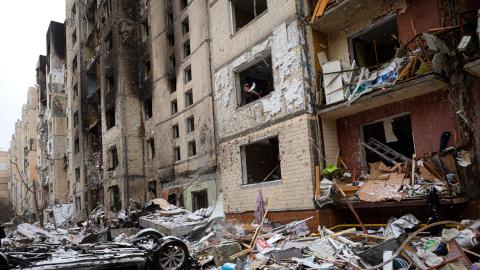Below Hudson Senior Fellow Can Kasapoğlu offers a military situation report about the war in Ukraine.
1. Battlefield Assessment
Last week, Russia reportedly captured around 25 square miles of territory from Ukrainian forces, which largely remained relegated to defensive positions. Open-source intelligence and close monitoring of battlefield trends suggest that further Russian gains are likely in the coming weeks.
Although its advances are not strategic in scope, the Russian military is accumulating stable tactical gains. Worse, the Kremlin’s political leadership, guided by its Soviet-remnant spy chiefs, has shown few qualms about pushing combat formations into battle even in the face of mounting casualties. Russia’s military brass, led by Defense Minister Sergei Shoigu and Chief of the General Staff Valery Gerasimov, know that retaining their posts depends upon their loyalty to the Kremlin rather than on their warfighting or command prowess. With high-ranking commanders willing to kowtow to political pressure, Russia’s maximalist political objectives are guiding its invasion campaign.
In a recent interview, Sergey Naryshkin, the head of Russia’s Foreign Intelligence Service (SVR), elaborated on those political objectives, claiming that Russia will not stop halfway before getting the job done, and predicting that a sad end awaits the government of Ukraine. His words reflect the geopolitical worldview conveyed by Vladimir Putin in 2021 in his irredentist article, “On the Historical Unity of Russians and Ukrainians,” and suggest that Russia’s ultimate goal remains nothing less than the dismantling of Ukraine as a sovereign political entity.
In service of this goal, Russia’s efforts on the battlefield this week continued to revolve around capturing the unoccupied remainder of Luhansk and Donetsk Oblasts. Positional fighting continued on most fronts. But Russian units are not statically deployed in trenches; Putin’s war machine is moving forward. In particular, Avdiivka and its surroundings played host to intense fighting, as Russian forces advanced near the city, though their gains came with heavy losses of personnel and armored vehicles.
In the south, once the staging ground for significant Ukrainian offensive action, Russian combat formations are fighting to maintain and fortify their frontline positions. It is Russian forces who are now taking offensive action, albeit with few territorial gains, near the Robotyne bulge, Ukraine’s most significant gain from its last counteroffensive. Krnyky, the site of the Ukrainian bridgehead across the Dnipro River, also saw combat action this week. Ukrainian combat formations have so far managed to defend the bridgehead successfully.
Russian aerial assaults concentrated on southern Ukraine this week. On January 25, Moscow launched waves of missiles and Iran-supplied loitering munitions at civilian infrastructure and industrial production facilities in several Ukrainian cities. Official Ukrainian reports suggested that the main targets of the aerial assault were the strategically valuable port city of Odesa and civilian residential units, electricity networks, and gas pipelines in Kharkiv. Most of Russia’s Shahed drones were reportedly intercepted, but despite the high interception rate, the attacks killed and injured several people across multiple cities and left thousands without electricity.
An open-source intelligence assessment of drone debris suggests that the Shahed-136 loitering munitions being deployed against Ukraine now possess advanced features, including non-resonant volumetric coating (NOP) that provides these munitions with a lower radar signature. Unconfirmed intelligence also suggests thermobaric warheads may have been introduced to the fight.
2. Both Sides Continue to Suffer from Insufficient Supplies of Armor
Necessity is proving to be the mother of invention for Russia and Ukraine, as the protracted nature of the conflict is pushing both sides to adopt increasingly innovative concepts to deal with a dearth of supplies amid high-tempo fighting. Intelligence from the battleground shows, for example, that Russian marines are mounting leftover RBU-6000 anti-submarine launchers onto T-80 tanks and MT-LB tractors.
Ukraine is dealing with similar challenges. According to German news reports, a lack of spare parts and supply difficulties are making it difficult for Ukraine to complete regular maintenance and repair on its Leopard-2 tanks. Evidence suggests that most Leopard-2s in Kyiv’s hands are intact. However, according to field assessments, some units have as low as 25 percent tank combat readiness. As per official reports, Ukraine is sending tank parts for repair and maintenance to Lithuania and Germany, leading to months-long delays and reducing the capabilities of Ukrainian ground forces.
As Ukraine prepares for reloaded counteroffensive efforts, ensuring a sustainable and safe supply of spare parts for its repair facilities is a new strategic priority for the West.
3. As Elections Near, Troubles Haunt Putin’s Russia
As the March elections near, Putin is fighting to maintain his hold on the presidency. Several political and economic factors might make Russia harder to run.
According to United Kingdom intelligence sources, the Kremlin is troubled by countrywide electricity disruptions that have led to heating and power outages. Findings show that in the past few months, heating breakdowns affected at least 16 locations across Russia. Some sources trace the problem to an underinvestment in public services during wartime, which has exacerbated existing flaws in the country’s infrastructure. The allocation of state resources from public services to Russia’s war efforts in Ukraine could haunt Putin in the upcoming election.
Resupply issues have also struck the Russian food and retail industry. Reportedly, Russians are complaining about shortages of in-demand food supplies in supermarkets. A worsening economic climate could spur harsh reactions against Putin, potentially weakening his popularity.
Worse, rates of alcohol abuse across the nation have reached Soviet-era levels. Some experts claim that this hike in alcoholism is already being reflected in a serious increase in violent crime rates. Further worsening the problem, the Wagner private military company’s recruitment from prisons has effectively pardoned a large number of convicts once incarcerated for severe crimes. At the conclusion of their military duty, these criminals have poured into Russian society unchecked. In the meantime, early signs of rising ethnic tensions have been detected in the recent protests in Bashkortostan, Russia’s most populous republic.
These developments alone will not cost Putin the election, the outcome of which has been predetermined by the Kremlin. Nor are the country’s growing difficulties likely to drag the federation into a civil war, at least not in the near term. But as Putin’s prolonged war continues to radicalize Russian society, he likely will find his fiefdom becoming increasingly unstable.














